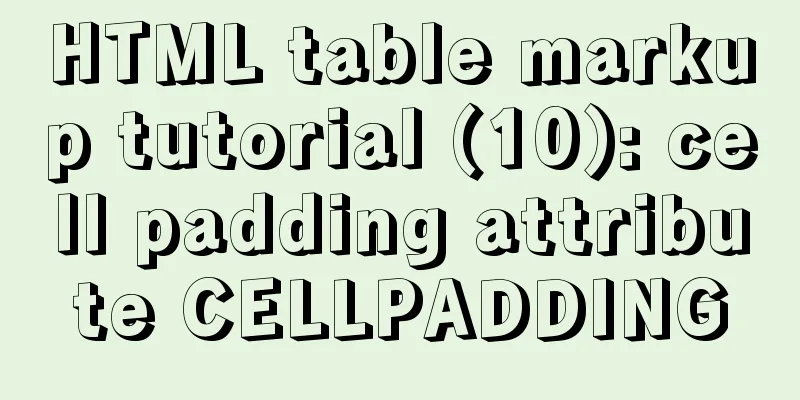Vue implements image dragging and sorting

|
This article example shares the specific code of Vue to implement image dragging and sorting for your reference. The specific content is as follows Principle: There is a list of pictures. Drag one of the pictures (triggering dragstart). When the dragged picture moves to the position of other pictures (triggering dragover), the dragged picture is moved from its original position to that position (triggering dragend). dragstart: The dragstart event is fired when the user starts dragging an element or a text selection. dragover: When an element or selected text is dragged over a valid drop target, the dragover event is triggered (once every few hundred milliseconds). dragend: The drag and drop event is triggered when the drag and drop operation ends. (We don’t need it here) (1) HTML structure of image list . Add the attribute draggable to the element that needs to be dragged. Please note here: the key value of the template for loop needs to be unique, because Vue will use in-place reuse when rendering. If the key value is unique, the list nodes rendered after reordering will not be reused, which can avoid some problems. (When we insert, we will insert certain data into the array according to the sequence number)
<ul class="drag-container"
@dragstart="onDragStart"
@dragover="onDragOver"
@dragend="onDragEnd"
ref="imgList">
<li
v-for="(item,idx) in list"
:key='item.path'
class="drag-list"
draggable="true"
>
<img :src="item.path" alt="" />
</li>
</ul>(2) Events : dragstart, dragover binding events onDragStart, onDragOver onDragStart: Identifies the element to be dragged and saves it in the state for use by the dragover binding event during the dragging process.
onDragStart(event){
console.log("start");
this.draging = event.target;
}, onDragOver: The event is triggered when the element is on a valid target during the dragging process. The target element is identified instead of the dragged element. First, identify whether the target element is the target element we need. In our example, determine whether it is a li element, and determine whether the image is the same as the dragged one, then insert the dragged element.
onDragOver(event){
console.log('drag move')
event.preventDefault();
let target = event.target;
//Because dragover will occur on ul, it is necessary to determine whether it is li
if (target.nodeName === "LI" &&
target.childNodes[0].src !== this.draging.childNodes[0].src) {
let idx_drag = this._index(this.dragging)
let idx_target = this._index(target)
let _list = this.list
let _drag = this.list[idx_drag]
if(idx_drag>idx_target){
_list.splice(idx_target,0,_list[idx_drag]);
_list.splice(idx_drag+1,1)
}else{
_list.splice(idx_target+1,0,_list[idx_drag]);
_list.splice(idx_drag,1)
}
console.log(_list[0].path)
this.$emit("change", _list)
}
},The complete code is as follows:
<template>
<div class="image-list" v-if="list && list.length">
<ul class="drag-container"
@dragstart="onDragStart"
@dragover="onDragOver"
@dragend="onDragEnd"
ref="imgList">
<li
v-for="(item,idx) in list"
:key='item.path'
class="drag-list"
draggable="true"
>
<img :src="item.path" alt="" />
</li>
</ul>
</div>
</template>
<script>
export default {
name:"drag-image-list",
props:{
list: Array,
},
data(){
return {
dragging:null, //The object being dragged}
},
methods:{
onDragStart(event){
console.log("start");
this.draging = event.target;
},
onDragOver(event){
console.log('drag move')
event.preventDefault();
let target = event.target;
//Because dragover will occur on ul, it is necessary to determine whether it is li
if (target.nodeName === "LI" && target.childNodes[0].src !== this.draging.childNodes[0].src) {
let idx_drag = this._index(this.dragging)
let idx_target = this._index(target)
let _list = this.list
let _drag = this.list[idx_drag]
if(idx_drag>idx_target){
_list.splice(idx_target,0,_list[idx_drag]);
_list.splice(idx_drag+1,1)
}else{
_list.splice(idx_target+1,0,_list[idx_drag]);
_list.splice(idx_drag,1)
}
console.log(_list[0].path)
}
},
onDragEnd(event){
console.log('end event')
},
_index(el){
var index = 0;
if (!el || !el.parentNode) {
return -1;
}
while (el && (el = el.previousElementSibling)) {
index++;
}
return index;
},
}
}
</script>The above is the full content of this article. I hope it will be helpful for everyone’s study. I also hope that everyone will support 123WORDPRESS.COM. You may also be interested in:
|
<<: How to connect to docker server using ssh
>>: How to avoid data loop conflicts when MySQL is configured with dual masters
Recommend
How to implement Docker to dynamically pass parameters to Springboot projects
background Recently, some friends who are new to ...
JS implements the dragging and placeholder functions of elements
This blog post is about a difficulty encountered ...
Detailed explanation of MySQL three-value logic and NULL
Table of contents What is NULL Two kinds of NULL ...
Installation and use of Ubuntu 18.04 Server version (picture and text)
1 System Installation Steps OS Version:1804 Image...
Introduction to Semantic HTML Tags
In the past few years, DIV+CSS was very popular in...
What is a MySQL tablespace?
The topic I want to share with you today is: &quo...
Summary of horizontal scrolling website design
Horizontal scrolling isn’t appropriate in all situ...
jQuery+h5 realizes the nine-square lottery special effect (front-end and back-end code)
Preface: Front-end: jq+h5 to achieve the nine-gri...
Solutions to problems related to software package dependency reporting during installation in Linux
Table of contents background 1) Enable the keepch...
A brief analysis of MySQL parallel replication
01 The concept of parallel replication In the mas...
Parse CSS to extract image theme color function (tips)
background It all started when a classmate in the...
Implementation of Docker to build Zookeeper&Kafka cluster
I've been learning Kafka recently. When I was...
Methods and steps to upgrade MySql5.x to MySql8.x
Several Differences Between MySQL 5.x and MySQL 8...
Vue implements a simple magnifying glass effect
This article example shares the specific code of ...
CSS3 implements missing corner rectangle, folded corner rectangle and missing corner border
Preface A few days ago, I came across the feature...









